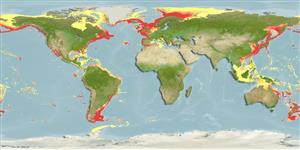Common names from other countries
Environment: milieu / climate zone / depth range / distribution range
Ecología
; salobre; rango de profundidad 0 - 1000 m (Ref. 116013). Polar
Atlantic, Pacific, Mediterranean, Arctic and Antarctic. Polar and subtropical.
Length at first maturity / Tamaño / Peso / Age
Maturity: Lm ? range ? - ? cm
Small unfascicled colonies; cnidome comprising only microbasic euryteles; female and male blastostyles completely reduced; immature female gonophore with unbranched spadix (Ref. 3086).
Maximum depth from Ref. 119523. Megabenthic species (Ref. 2952). Found at depths of 1 to 7 m on rocks or living as an epizoite on ascidians, barnacles, mussels, and sponges. Colonial (Ref. 3086). Known from sheltered areas of bays, including mangrove shores and sounds (Ref.86643). Found on the brown alga Cystoseira crinita (Ref. 116447).
Life cycle and mating behavior
Madurez | Reproducción | Puesta | Huevos | Fecundidad | Larva
Reproduction occurs only in hydroid stage (Ref. 1663, p. 13).
Migotto, A.E., A.C. Marques, A.C. Morandini and F.L. da Silveira. 2002. (Ref. 813)
IUCN Red List Status (Ref. 130435)
CITES status (Ref. 108899)
Not Evaluated
Not Evaluated
Human uses
| FishSource |
Herramientas
Más información
Age/SizeCrecimientoLength-weightLength-lengthMorfologíaLarvaAbundancia
Fuentes de Internet
Estimates based on models
Preferred temperature
(Ref.
115969): 5.8 - 25.2, mean 12.1 (based on 3066 cells).
Price category
Unknown.
